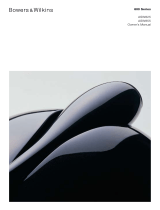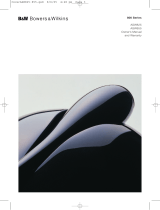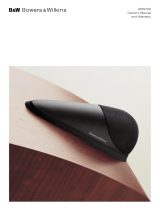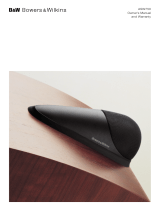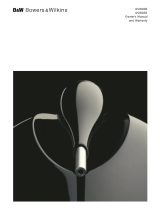Page is loading ...

Manual
ASW10CM S2
B&W Group Ltd
Dale Road
Worthing West Sussex
BN11 2BH England
T +44 (0) 1903 221800
F +44 (0) 1903 221 801
www.bowers-wilkins.com
B&W Group (UK Sales)
T +44 (0) 1903 221 500
B&W Group North America
T +1 978 664 2870
B&W Group Asia Ltd
T +852 3 472 9300
Copyright © B&W Group Ltd. E&OE
Printed in China.
210mm
Spine width to be
adjusted currently set
210mm

4
ENGLISH
1. Unpacking
Carton Contents
Check in the carton for:
1 Mains cable
1 Accessory pack containing
4 Rubber feet
4 M4 spike feet
4 Lock nuts (10mm across ats)
Environmental Information
This product complies with international directives,
including but not limited to:
i. the Restriction of Hazardous Substances (RoHS) in
electrical and electronic equipment
ii. the Registration, Evaluation, Authorisation and
restriction of CHemicals (REACH)
iii the disposal of Waste Electrical and Electronic
Equipment (WEEE).
Consult your local waste disposal authority for
guidance on how properly to recycle or dispose
of this product.
The subwoofer has been designed both for Home
Theatre installations and to augment the bass
performance of ‘full range’ speakers in 2-channel
audio systems. All audio installations require some
thought in installation if they are to reach their full
performance potential and this manual will guide
you through the process.
The subwoofer requires connection to the mains power
supply, so it is important that you familiarise yourself
with the safety instructions and heed all the warnings.
Keep this manual in a safe place for future reference.
The Subwoofer Connection and Control Panel
1. Status indicator.
2. On, Auto, Stand-by switch.
3. Line-level input volume.
4. Speaker level input volume.
5. Low-pass lter frequency.
6. Low-pass lter selection switch.
7. Bass extension switch.
8. Equalisation switch.
9. Phase reverse switch.
10. 12V trigger input.
11. Line level input sockets (left and right).
12. Speaker level input binding posts (left and right).
13. Mains input.
14. External fuse holder.
Subwoofer Applications
The primary function of a subwoofer is to reproduce
signals from an audio-visual processor's Low
Frequency Effects (LFE) channel. In addition, the
processor may be congured to divert the low
bass portion from some or all of the other channels
and add it to the LFE information. This is usually done
by selecting “small” loudspeakers in the processor
set-up procedure.
In 2-channel audio applications a subwoofer is used
to extend the bass response lower than that provided
by the satellite speakers. The subwoofer low-pass lter
should be set so that the subwoofer takes over as the
output of the satellite speakers falls.
Subwoofer Positioning and Installation
The ear poorly perceives the source location of low
frequency sound so the position of subwoofers in the
listening room is generally less critical compared to
full-range speakers. However, best results are usually
obtained if the subwoofer is placed between the left
and right speakers or in the vicinity of one of them.
If two subwoofers are used, it is best to put one
near the left and one near the right speaker. Placing
a subwoofer behind the listening position, even in
multichannel surround sound installations, generally
results in inferior imaging, but may be an acceptable
compromise if domestic considerations dictate.
2. Positioning
1
2
3
4
5
6
7
8
10
12
13
9
11
14
ENGLISH

5
ENGLISH
As with all speakers, the proximity of room boundaries
affects the sound of a subwoofer. Bass volume
increases as more surfaces come into close proximity
with the speaker. Unlike full-range speakers, however,
the overall system balance can be corrected by
adjusting the volume level of the subwoofer. The more
boost gained from the room, the lower the volume
can be set and the less hard the subwoofer has to
work; but there is a down side. Subwoofers positioned
near corners often generate more low-frequency
room resonances, making the bass more uneven with
frequency. There is no substitute for experiment as all
rooms behave differently, so the subwoofer should be
tried in a variety of positions before a nal decision is
made. A piece of music with a bass line ascending or
descending the musical scale is useful for assessing
the smoothness of the bass response. Listen for
exaggerated or quiet notes.
If the subwoofer is to be used in a conned space (e.g.
built into furniture), the space must be ventilated to
allow sufcient air to circulate and cool the unit. Ask
your dealer for advice.
The subwoofer is intended to be oor mounted only.
It is important to ensure the subwoofer stands rmly
on the oor using the spike feet supplied whenever
possible. The spike feet are designed to pierce carpet
and rest on the oor surface. Initially, screw the lock
nuts onto the spikes enough to leave the nuts oating
just above the carpet when the spikes are resting
on the oor beneath. Screw the spikes fully into the
threaded inserts in the base of the cabinet. If the
cabinet rocks when placed on the oor, unscrew the
two spikes that do not touch the oor until the cabinet
rests rmly without rocking. Finally, lock the nuts
against the cabinet. It may be more convenient to t
and adjust the spike feet after speaker positioning has
been optimised.
If there is no carpet and you wish to avoid scratching
the oor surface, use either a protective metal disc
(a coin perhaps) between the spike and the oor or
use the supplied rubber feet. Fit the rubber feet by
screwing one into each of the holes in the underside
of the cabinet.
The grille tted to the front of the subwoofer may be
removed if desired. Take care however not to touch the
moving parts of the drive unit as damage may result.
Using Multiple Subwoofers
Using multiple subwoofers in a single installation can
improve performance in the following ways:
• Maintain stereo separation to the lowest
frequencies.
• Smooth out the effects of low frequency room
resonances.
• Enable a higher maximum sound output.
In the case of two subwoofers used in a 2-channel
audio system, stereo separation will only be improved
if each channel has its own subwoofer located close to
the appropriate satellite speaker.
Contents
ENGLISH 4
1. Unpacking 4
2. Positioning 4
3. Connections 6
4. Switch on and setup 7
5. Fine Tuning 9
6. Aftercare 10

6
ENGLISH
3. Mono/LFE line level input - RCA Phono socket
For mono applications, such as the subwoofer or LFE
output from a surround processor, use just one of the
line input sockets on the subwoofer. It does not matter
whether you use left or right.
Before Auditioning
Before auditioning your new subwoofer installation
and ne-tuning it, double check the connections.
Make sure in particular that:
1. The phasing is correct. If the speaker level inputs
are used, ensure that the positive terminals on the
subwoofer (marked + and coloured red) are connected
to the positive output terminals on the amplier and
that the negative terminals on the subwoofer (marked
– and coloured black) are connected to the negative
output terminals on the amplier. Incorrect connection
can result a confused sound with poor bass.
2. Left to right channels are not confused. Left/right
confusion can result for example in orchestral elements
appearing in the wrong place in the stereo image, or
Home Theatre sound effects not matching the action
on screen.
Disconnect all audio system equipment from the
mains until the signal connections have been made
and checked. This avoids the risk of damage whilst
connections are made or broken. The subwoofer
can accept both line level signals via the RCA Phono
sockets and speaker level signals via the binding posts.
Use appropriate high quality interconnect cables.
1. Speaker level stereo inputs – Binding posts
This option is provided if you are using an integrated
amplier with no line level outputs, see above diagram.
2. Stereo line level inputs - RCA Phono sockets
If you are using separate pre- and power ampliers, or
have an integrated amplier with line level pre-amplier
outputs, you may connect the subwoofer via its line
level inputs.
If your pre-amplier only has a single set of outputs,
you may use Y connectors to give additional
connections for the subwoofer.
3. Connections
Right Speaker Left Speaker
Right Speaker Left Speaker

7
ENGLISH
Audio-visual processors incorporating an “automatic”
set up procedure may be “confused” by subwoofers
with an auto switch-on/sleep function. A potentially
damaging fault condition can arise. Subwoofers are
best left switched on and fully active during set up if
such a processor is used.
Note:Insomesituations,otherequipment
switchingonoroffmaycreateaspikeinthemains
powersupplysufcienttocausetheauto-offtimer
toreset.Shouldthatoccur,thesubwooferwillstay
onforafurther30minutes.
Standby: With the switch set to Standby the
subwoofer will become active when 12V is applied to
the Trigger Input (Number 10 above). Zero volts at the
input will return the subwoofer to sleep. The indicator
will glow green when the subwoofer is active and red
when the subwoofer is in sleep.
Setting The Subwoofer Controls
There are 7 controls to consider:
• The VOLUME (LINE) control (Number 3 above)
• The VOLUME (SPEAKER) control (Number 4
above)
• The LOW-PASS FREQ (frequency) control
(Number 5 above)
• The LOW-PASS FILTER switch (Number 6 above)
Note: This applies only to the LINE input. The
lter is always in circuit with the SPEAKER LEVEL
input.
• The BASS Extension switch (Number 7 above)
• The EQ (equalisation) switch (Number 8 above)
• The PHASE switch (Number 9 above)
The appropriate settings depend on the equipment
used with the subwoofer and the modes of connection.
If using more than one subwoofer, ensure the controls
on each one are set the same.
Note:TheVOLUME(LINE)andVOLUME
(SPEAKER)controlsonlyoperateontheir
respectivelineandvolumeinputs.Anunused
volumecontrolisbestsettoMin.
Switching On and Off
Subwoofers are best switched on after any other item
and switched off rst. The On/Auto/Standby switch
(Number 2 above) and Status Indicator (Number 1
above) operate as follows:
On: With the switch to On, the subwoofer will remain
fully active and the indicator will glow green.
Auto: With the switch set to Auto, the subwoofer will
initially become fully active and the indicator will glow
green. After about 30 minutes without an input signal,
the subwoofer will automatically enter “sleep” mode.
The indicator will glow red. When an input signal is
detected, the subwoofer will automatically become
active and the indicator will glow green. The subwoofer
will return to sleep after about 30 minutes with no
input signal.
4. Switch on and setup
1
2
3
4
5
6
7
8
10
9

8
ENGLISH
1. Home Theatre Settings
Set the VOLUME (LINE or SPEAKER) control initially
to the 9 o’clock position.
Set the LOW-PASS FILTER switch to OUT.
Set the EQ switch initially to position A.
Set the PHASE switch initially to 0°.
Set the LOW-PASS FREQ (frequency) control to
140 if the speaker level inputs are used. The setting
is irrelevant if the line level inputs are used.
See the “Fine Tuning” section for more.
The subwoofer is not a THX® licensed component, but
may be used with a THX® controller if desired. If a THX®
controller is used, ensure that the subwoofer function
is enabled. This incorporates all the ltering and level
setting required for the subwoofer in all modes. For
level calibration, the internal test noise and channel
level controls in the THX® controller should be used.
In all cases the levels should be set to obtain 75dB
SPL (C-weighted) at the listening position from the
controller’s internal noise test signal.
With other processors, congure the front and
surround speakers to “large” or “small” as appropriate
before setting the levels. Use the internal noise test
signal and volume controls of the processor to set the
levels of all the speakers. Only change the VOLUME
control on the subwoofer if there is not enough range in
the processor to achieve the correct levels.
Inexpensive sound level meters are readily available
from electronics stores and can be used to calibrate
the levels. Refer to your processor manual for further
details on how to set the levels.
2. 2-channel Audio Settings
Set the VOLUME (LINE or SPEAKER) control initially
to the 9 o’clock position.
Set the LOW-PASS FILTER switch to IN.
Set the EQ switch initially to position A.
Set the PHASE switch initially to 0°.
Set the LOW-PASS FREQ control to match the
-6dB low frequency cut-off frequency of the satellite
speakers. Note: Both -3dB and -6dB gures can be
found in the specication of each B&W speaker model.
If the satellite speaker manufacturer quotes only a -3dB
frequency, the optimum setting for the LOW-PASS
FREQ control should be between 0.6 and 0.9 times
that gure. The more gradual the low frequency roll-
off of the satellite speakers, the lower the frequency
should be set.
See the Fine Tuning section for more.

9
ENGLISH
Home Theatre
In home theatre systems, the subwoofer (LFE) signal
is a separate channel rather than an extension of the
signal to the satellite speakers. The LOW-PASS FILTER
is switched out (or set to maximum), because the
processor provides all the ltering for any speakers set
to “small”. However, the position of the PHASE switch
must still be assessed. Normally the phase will be set
to 0°, but if the subwoofer is positioned at a distance
signicantly different from the other speakers, or the
power amplier driving the other speakers happens to
invert the signal, the 180° position may be preferable.
Listen with the switch in both positions and choose
the one that gives the fullest sound. If there is little
difference, leave the switch at 0°.
Surround sound processors normally have a calibrated
noise signal that can be used to set the relative levels
of all the speakers, making the task somewhat more
straightforward than for 2 channel audio. However,
do not be afraid to alter the settings to your personal
preference. It is all too easy to get carried away with
the capabilities of the subwoofer, especially with some
special low-frequency effects. Often a more realistic
portrayal, and one more satisfying in the long term, is
to be had by setting the subwoofer level lower than the
standard calibration level.
2-channel Audio
Set the system up in the preferred position and play
some programme with a steady bass content.
The optimum settings of the PHASE switch and the
LOW-PASS FREQ control are inter-related and also
dependent on the low-frequency cut-off characteristic
of the satellite speakers. However, the settings
recommended above for the LOW PASS FREQ control
and PHASE switch have been chosen to integrate well
with most satellite speaker bass alignments.
Using the initial settings, rst check the setting of
the PHASE switch. Choose the option that gives the
fullest sound. Normally the recommended option will
be optimum, but may not be in certain circumstances.
These may be that the power ampliers feeding
the satellite speakers invert the signal or that the
subwoofer is not placed close to the satellite speakers.
Next, adjust the VOLUME (LINE or SPEAKER) of the
subwoofer relative to the satellite systems to your
liking. Use a wide variety of programme material to get
an average setting. A setting that sounds impressive on
one piece may sound overpowering on another. Listen
at a realistic volume level as the perception of musical
balance varies with sound level.
Finally, adjust the LOW-PASS FREQ control to give
the smoothest transition between the subwoofer and
satellite speakers.
All Applications
The BASS EXTENSION switch offers three options
of subwoofer bass extension. Position A gives the
greatest extension and position C gives the least
extension. Position B provides a compromise setting.
If the system is to be used at very high volume levels
or in a large listening room, restricting the bass
extension by selecting either B or C may help
ensure that the subwoofer is not asked to exceed
its performance limits. In most situations the BASS
EXTENSION switch should be left in position A.
The EQ switch alters the subwoofer bass roll-off
alignment. The bass you hear is a combination of the
subwoofer plus the effects of the room and you should
choose the position that best complements your room
and the location of the subwoofer. Position A gives a
“drier” alignment, more suited to placing the subwoofer
in a corner or compensating for a resonant room.
Position B is suited to a less resonant room acoustic
and use away from a corner.
5. Fine Tuning

10
ENGLISH
If you get problems with uneven bass – certain bass
notes are exaggerated more than others – then you
probably have a room interface problem and it is worth
experimenting with the location of the subwoofer.
What may seem like small changes in position – 15cm
(6in) or so – can have a profound effect on the sound.
The use of multiple subwoofers can smooth the
effects of room resonances, as each subwoofer will
tend to excite resonances at different frequencies. If
you appreciably alter the relative distances from the
subwoofer(s) and satellite speakers to the listening
position, re-assess the PHASE switch setting. You
should also check the volume of the subwoofer (using
either the processor output levels or the VOLUME
control on the subwoofer amplier as appropriate),
but only after setting the phase correctly.
The cabinet surfaces will usually only require dusting.
If you wish to use an aerosol or other cleaner, apply
the cleaner onto the cloth, not directly onto the product
and test a small area rst, as some cleaning products
may damage some of the surfaces. Avoid products
that are abrasive, or contain acid, alkali or antibacterial
agents. Marks on the paint surface may be removed
with a dilute perfume-free soap solution. Remove any
remaining streak marks by spraying with a proprietary
glass cleaner and lightly wiping dry with a microbre
cloth. Do not use cleaning agents on the drive units
and avoid touching them as damage may result.
6. Aftercare


Manual
10CM S2
B&W Group Ltd
Dale Road
Worthing West Sussex
BN11 2BH England
T +44 (0) 1903 221 800
F +44 (0) 1903 221 801
www.bowers-wilkins.com
B&W Group (UK Sales)
T +44 (0) 1903 221 500
B&W Group North America
T +1 978 664 2870
B&W Group Asia Ltd
T +852 3 472 9300
Copyright © B&W Group Ltd. E&OE
Printed in China.
210mm
Spine width to be
210mm
/


